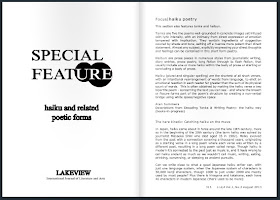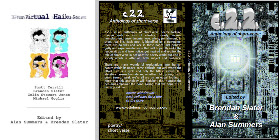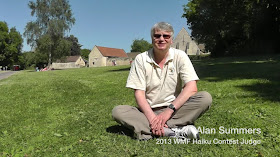Extended Judge’s Report for 2013 World Monuments Fund Haiku
Contest continuing from:
n.b. Which monument
am I sat in front of?
See at the very end.
Haiku (plural
and singular spelling) are the shortest of all short poems, and rarely take
longer than six seconds to read. Although there are many approaches, the most
commonly recognised version is that of three very short lines, containing two
images often, but not always, taken from real life, that bounce off each other.
These two images may or may not have an obvious connection
at first reading, but create a friction where two things rub up against each
other and the reader can make up their own new third or overall image, and
become joint poet during that time.
This kind of short poem works well if it’s especially
crafted with a well-written and intentional rearrangement of words from our
common language, that pulls an emotional connection, and reaction, out of us
which makes us feel included.
Haiku often allow every reader to be a joint creative
writer/reader while they read it, and the poem should feel far greater than the
sum of its physical count of words.
So what
actually makes a haiku?
To start with, haiku is commonly
known as a poem with three very short lines. By the way, the word haiku means both a single haiku and the
plural of haiku, something we’ve taken from the Japanese lack of singular and
plural meanings in their language, which makes for interesting slants of
meaning.
In Japan, haiku came about in
force, back at the end of the 19th century and very beginning of the
20th century, (haiku is the term coined by Masaoka Shiki who died
aged 35 in 1902). Though very
modern, like most things, it’s connected to the past just as music is, for
instance.
Haiku came from a connection with
other literature covering a thousand years, when it evolved from being a
starting verse in a long poem where each verse was written by different poets,
and this long poem was called renga, and then after Basho (1644 – 1694), as
renku.
Why is haiku so
popular in the Western world?
It should be easier for Japanese people
to write haiku because of their multi-based language system, yes they have
three systems, we only have the one with just 26 letters. The Japanese language systems have such
a rich resource to capture an incredible amount of detail within so few characters
and ideograms.
Yet an incredible amount of people
attempt to write haiku in English all around the world, and I’m glad that they
do.
Back to Japanese, can we write
close to what a good Japanese haiku writer can, with just the one language
system that we have, when…
The Japanese
system of characters for their language:
 |
| ©Smashing Magazine http://www.smashingmagazine.com/2010/05/18/the-beauty-of-typography-writing-systems-and-calligraphy-of-the-world/ |
There are 50,000 kanji characters, but 1000 to just under 2000 are used by most
people (phew!)
Then there are hiragana and katakana: each
have 46 characters in modern use (there used to be more).
Kanji represents ideas or objects, hiragana expresses the
grammatical relationships between them. Katakana is used to write words which have been borrowed from other
languages, including various foreign names and names of countries.
The pool in total that many
ordinary Japanese haiku poets might use is around 2040 characters or greater,
instead of the 26 letters of the single English-language alphabet that we
use. Oh, and don’t forget that
punctuation in Japanese is in words not symbols, as we use in English, and they
are part of the sound-unit aka ‘on’
count as part of the poem, so that a 17-on Japanese haiku could be 15 or 16
sound-units long, plus one or two sound units that are the punctuation
‘word-phrases’.
A haiku is so brief it could easily
be written on the back of a postage stamp (remember those things before txt
messaging, and other social media?) but the techniques to make a good haiku
could fill something the size of a novella, and millions of people every day
have a go all the same, which is great news for us.
Regarding "on" and its mora length and nature here are three useful web links:
Haiku in
English
 |
| copyright©Alan Summers, With Words |
So how do we read, and even write,
something so short as haiku in English that can still end up as a poem, without
the benefit of the complex set of systems that the Japanese have? As Japan borrowed art and writing
techniques to incorporate into the modern haiku so we too borrow from them to
do our haiku, with techniques taken from their use of a reference to a season
or part of a season (kigo), and how to
insert a type of pause between the two short parts of a haiku (kire, kireji).
The main characteristics of a haiku
are two images that work well together, not necessarily close in direct subject
matter, sometimes in slight opposition to each other: A juxtaposition is the
most commonly used method, although there are others, especially in
contemporary haiku, such as disjunctive methods. I will touch on this at a later date. But for now…
Those two images create an
electricity, charging up the reader to create their own vision of what the
haiku has become as a poem.
Haiku work best with concrete
images, yet often with a fine tightrope walk between objective and subjective
phrasing. This balancing act can
be enhanced by other approaches, for example, fixing the haiku into part of a
season, think Independence Day or Martin
Luther King Day, or the British Guy
Fawkes Day/Bonfire Night. This can pin a haiku to a specific part
of a season, even a day, and it’s amazing how other memories can flood in when
this method is used. Remember, haiku are not so much nature poems but seasonal
poems so urban subjects can of course be included.
It’s good to write a haiku in the
present tense so that a reader feels the incident being recorded as a haiku
poem has been so recent, that the reader need only turn their head to spot the
moment being carried out. That
they too can become a witness alongside the original author of the poem who has
recorded the incident as it happened.
This is a useful method so that each reader becomes a joint witness,
even if the moment happened months or even years ago. That’s one of the tricks or techniques that can be utilised
in modern haiku.
One of the secrets of haiku is
gently unearthing the reader’s creativity, reawakening the wonder of day to day
life, and dismissing our sometimes jaundiced view of the world. As haiku can
also be poems of place, in natural or urban settings, they are perfect for the
World Monuments Fund Haiku Contest.
What did I look for when judging
the World Monuments Fund Haiku Contest?
Some of the above I’ve just stated,
and also another technique, that of switching our perspective from something
big to something small, or the reverse, to zoom in and then zoom out. Something very effective in such a
small tiny poem as haiku.
So what were the season time
stamps in many of the winning haiku?
cricket is an Autumn
seasonal reference in Japanese haiku, a time of reflection, memories, and a
certain wistful sadness.
stars is also an Autumn
reference, in the Japanese poetical sense.
butterflies are usually a Spring reference in Japanese haiku.
robin is usually seen as a seasonal reference to Spring in North
America, and a Summer kigo in Japan, for the Japanese Robin. In Britain the robin is a strong
seasonal reference for Christmas unless accompanied with a dominant seasonal phrase
from another season.
My Judge’s Report
A fine selection of verses which took quite a time to
finally whittle down to a shortlist of first nine haiku, finally becoming six
haiku, in order to pick prize-winning authors, and semi-finalists. Because of
the nature of the organisation holding the competition, and that I am
fascinated and moved by a strong sense of place (both external and/or
internal), and identification with that place, each of the entries went through
a tough and ruthless process. The final shortlisted haiku had to endure further
relentless scrutiny and even further relentless scrutiny for a chance to earn
their positions in the winning places of this competition.
First Prize, The Endless Column
I kept coming back to the Endless Column which seemed to
both represent a particular place and event but also so much struggle in so
many countries, not just Romania, but every country through time. The mention of a cricket (another
cricket) counting stars is a magical and memorable part of this haiku. The two images worked well bouncing off
each other, and another cricket is counting the stars lifted this haiku quite literally beyond its
immediate place to perhaps one of Japan’s favorite haiku writers, that of Issa,
who felt at one with all insects in particular, because of his tough and
challenging life.
The second prize
seems to beautifully capture so much of what is great about the American
expanses, and how vital Route 66 is for American culture and for anyone who has
travelled, or read about this amazing road, perhaps one of the biggest places,
and monuments, and an iconic inspiration to those both inside and outside
America. Many of us are at a
crossroads at some time in our lives, and perhaps passed by a rain-filled
hubcap teeming with stars
which is such a terrific phrase for a haiku.
The third prize haiku
combines the history of a world famous site known to many across media
platforms as the Wailing Wall but by other names by those who live there. It is a site for prayer and pilgrimage
which dates back to the 4th century.
But do we not all need sustenance of one kind or another, even
butterflies taking salt from the mud close to this religious place?
The Semi-finalists
also, in their own individual manner, encapsulated something of the essence of
place, from the famous maze of Henry VIII’s Hampton Court, with its incredible
history and mix of complex politics, to the monument of love that the Taj Mahal
represents, to Ha Long Bay, a precious and fragile area under risk from the
tourist industry.
Alan Summers,
Japan Times award-winning writer
First Prize: Christina Oprea
Site: Endless Column
________________________________
the Endless Column -
somewhere, another cricket
is counting the stars
Second Prize: Mark E. Brager
Site: Route 66
________________________________
crossroads . . .
a rain-filled hubcap
teeming with stars
Third Prize: Mike Blottenberger
Site: Wailing Wall
________________________________
near the Wailing Wall
butterflies drinking salt
from the mud
Semi-finalist #1: Matthew Paul
Site: Hampton Court
________________________________
spring wind
a robin at Hampton Court
enters the maze
Semi-finalist #2: Neal Whitman
Site: Taj Mahal
________________________________
chemotherapy
photographs of Taj Mahal
in a well-thumbed book
Semi-finalist #3: Carol Judkins
Site: Ha Long Bay
________________________________
gold rush-
in Ha Long Bay,
the dragon weeps
Please do visit the video of the award-winning entries:
Where am I sitting?
I’m sitting in Barton Farm
Country Park in Bradford on Avon:
In front of the 4th
Century Tithe Barn (with a large cross shaped opening/window):
ENGLISH HERITAGE:
http://www.english-heritage.org.uk/daysout/properties/bradford-on-avon-tithe-barn/
http://www.english-heritage.org.uk/daysout/properties/bradford-on-avon-tithe-barn/history-and-research/
Bradford on Avon Tithe Barn:
http://www.bradfordonavon.co.uk/WhatToDo/tithebarn.html
This shows the other side of that cross shaped window opening:
http://www.panoramio.com/photo/2739899
Alan Summers,
a double Japan Times
award-winning writer, Pushcart Prize and Best Small Fictions nominated, now based in Chippenham, England, runs Call of the Page, which
provides literature, education and literacy projects, as well as online courses
often based around the Japanese genres.
He is a past co-founding editor for Bones Journal (contemporary haiku), and his latest full-length collection Does Fish-God Know contains contemporary and experimental haiku with short verse published
by Yet To Be Named Free Press.
Various essays and articles include:
Haiku: The Art of Implication over Explication
575haiku - Traditional Haiku as three lines and in a 5-7-5 English language syllables pattern
Travelling the single line of haiku:
The Reader as Second Verse
Black dogs and afternoon rain:
Themocracy: The Themocrats and their Concept Albums
Four book reviews by Alan Summers of writers who weave theme:
The Golden Carousel of Life:
Senryu, An Application to be a) human
Failed Haiku: A Journal of English Senryu
We run various popular courses:
https://www.callofthepage.org/courses/
Haiku (plural and singular spelling) are the shortest of all short verses, with an intended arrangement of words to draw on an emotional reaction from a reader. The intention is to create an effect far greater than the sum of the actual number of words used.
“…a haiku often juxtaposes two [different] objects and challenges the reader to make an imaginary connection between them.”
From the Preface viii, Light Verse from the Floating World by Makoto Ueda
Columbia University Press, New York 1999
Traditionally haiku are rooted in the seasons, and you can have half the poem already written by adding a season. Haiku are also ideal for urban observations, and as a kind of short-hand for remembering events, the important days in our lives, and the often overlooked things that do matter and risk being forgotten. Haiku can also make for excellent ecological and environmental writing.
Above all these incredibly distilled verses can be wonderfully therapeutic. They can also work out both the ‘right’ and the ‘left’ side of the brain which is a useful exercise to help stave off memory deterioration.
The secret of haiku is gently unearthing both our own creativity; reawakening or reigniting the wonder of day to day life and that of the reader too. It’s can be about dismissing or reducing our media jaundiced view of the world which is healthy even in the best of times and especially in the worst of times, to paraphrase Charles Dickens and the opening line to A Tale of Two Cities.
Haiku is The Golden Thread and our various haiku courses can help you find it.
For information on our popular online courses for haiku, and tanka poetry, or haibun or tanka story/prose please feel free to contact Karen Hoy, Course Director, at: admin@callofthepage.org
.










































